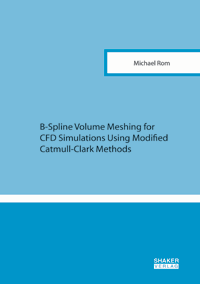
Shop : Recommendation
Shop
Recommendation
48,80 €ISBN 978-3-8440-3421-9Softcover190 pages96 figures282 g21 x 14,8 cmEnglishThesis
March 2015
Christian Michael Rom
B-Spline Volume Meshing for CFD Simulations Using Modified Catmull-Clark Methods
In this thesis, new techniques for the fast semiautomatic generation of high-quality block-structured B-spline volume meshes for numerical flow simulations are presented. The starting point is a given surface of arbitrary topology representing an object in a flow field. It is defined by a collection of untrimmed or trimmed B-spline patches described by parametrizations which are usually not suitable for numerical flow simulations, e.g., due to gaps or overlaps.
The first part of the mesh generation process developed in this work is the generation of a surface mesh as a control mesh for a Catmull-Clark surface which approximates the given surface. For this purpose, an initial coarse polyhedron has to be constructed manually or with the aid of templates first. A control mesh is then generated from this initial polyhedron by applying an iterative surface fitting approach. The first iteration step is a subdivision of the initial polyhedron using a modified Catmull-Clark method. The modification allows for modeling sharp creases. The second iteration step precomputes points of the Catmull-Clark limit surface. These limit points are projected onto the target surface in the third iteration step by applying the Nelder-Mead algorithm. In the last iteration step, the projected points are approximated using the CGLS method to obtain new surface mesh vertices with improved approximation properties for the following iteration loop. User interventions, e.g., for surface mesh smoothing, parameter correction or feature detection, are possible at any stage of the iterative process. The surface meshing is finished when the approximation of the given surface is sufficient, measured by the distance of the limit points to the B-spline surface. The convergence behavior of the iterative process is investigated.
The extension of the surface mesh to a volume mesh is done in two steps: first, an offset mesh is attached to the surface mesh for the accurate resolution of thin boundary layers, which occur in viscous fluid flow close to objects, e.g., for high Reynolds number flows. The second step of the volume mesh generation is the construction of a far-field mesh which is attached to the offset mesh. This is the part of the meshing process of this work which needs the most user input.
In a last step, the final volume mesh is converted into a block-structured B-spline mesh. The inner surface mesh can then be understood as a control mesh for a B-spline surface described by a watertight reparametrization of the given B-spline surface. Further refinements of the volume mesh can then be applied by spline evaluation. Alternatively, an extension of the Catmull-Clark rules for the application to volumes can be used. If the offset and the far-field mesh are generated during the iterative surface meshing process, this process can be continued by replacing the surface subdivision in the first iteration step by volume subdivision. The final B-spline volume meshes are well-suited for adaptive flow simulations.
The new meshing techniques are tested for two different wing-fuselage configurations and an airplane engine. For one of the wing-fuselage configurations, results of numerical simulations with the adaptive finite volume flow solver Quadflow are compared with experimental data obtained from wind tunnel readings.
The first part of the mesh generation process developed in this work is the generation of a surface mesh as a control mesh for a Catmull-Clark surface which approximates the given surface. For this purpose, an initial coarse polyhedron has to be constructed manually or with the aid of templates first. A control mesh is then generated from this initial polyhedron by applying an iterative surface fitting approach. The first iteration step is a subdivision of the initial polyhedron using a modified Catmull-Clark method. The modification allows for modeling sharp creases. The second iteration step precomputes points of the Catmull-Clark limit surface. These limit points are projected onto the target surface in the third iteration step by applying the Nelder-Mead algorithm. In the last iteration step, the projected points are approximated using the CGLS method to obtain new surface mesh vertices with improved approximation properties for the following iteration loop. User interventions, e.g., for surface mesh smoothing, parameter correction or feature detection, are possible at any stage of the iterative process. The surface meshing is finished when the approximation of the given surface is sufficient, measured by the distance of the limit points to the B-spline surface. The convergence behavior of the iterative process is investigated.
The extension of the surface mesh to a volume mesh is done in two steps: first, an offset mesh is attached to the surface mesh for the accurate resolution of thin boundary layers, which occur in viscous fluid flow close to objects, e.g., for high Reynolds number flows. The second step of the volume mesh generation is the construction of a far-field mesh which is attached to the offset mesh. This is the part of the meshing process of this work which needs the most user input.
In a last step, the final volume mesh is converted into a block-structured B-spline mesh. The inner surface mesh can then be understood as a control mesh for a B-spline surface described by a watertight reparametrization of the given B-spline surface. Further refinements of the volume mesh can then be applied by spline evaluation. Alternatively, an extension of the Catmull-Clark rules for the application to volumes can be used. If the offset and the far-field mesh are generated during the iterative surface meshing process, this process can be continued by replacing the surface subdivision in the first iteration step by volume subdivision. The final B-spline volume meshes are well-suited for adaptive flow simulations.
The new meshing techniques are tested for two different wing-fuselage configurations and an airplane engine. For one of the wing-fuselage configurations, results of numerical simulations with the adaptive finite volume flow solver Quadflow are compared with experimental data obtained from wind tunnel readings.
Keywords: Block-Structured Volume Mesh Generation; Catmull-Clark Subdivision; B-Spline Surfaces and Volumes; Reparametrization; Computational Fluid Dynamics
The recommendation will be sent by email to the address you provide below.
Fields marked with * are mandatory! Please fill them out completely.
Shaker Verlag GmbH
Am Langen Graben 15a
52353 Düren
Germany
Am Langen Graben 15a
52353 Düren
Germany
Mon. - Thurs. 8:00 a.m. to 4:00 p.m.
Fri. 8:00 a.m. to 3:00 p.m.
Fri. 8:00 a.m. to 3:00 p.m.
Contact us. We will be happy to help you.



